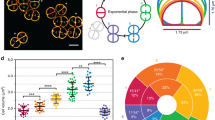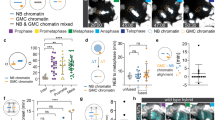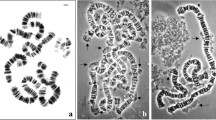Abstract
IT has been suggested from McLeish's cytological studies of the broad bean, Vicia faba, that a nucleus lacking a nucleolus cannot reproduce1. Similarly, Gaulden and Perry2 have shown that mitosis in the grasshopper neuroblast is permanently inhibited when one of two nucleoli is irradiated with an ultraviolet microbeam. The attached X attached XY system (\(\overline{XX}\), \(\overline{XY}\)) constructed by Lindsley and Novitski3 in Drosophila provides an opportunity for investigating in another organism the behaviour of a nucleus that is deprived of a nucleolus. Nucleolus organizer regions exist on both the X and Y chromosomes of Drosophila, and none exists on the autosomes. When an \(\overline{XX}\) female is crossed to an \(\overline{XY}\) male, four types of zygotes are obtained, each containing the complete set of autosomes, but varying in sex chromosome constitution. With respect to the sex chromosomes, the zygotes are \(\overline{XX}\)/O, \(\overline{XY}\)/O, \(\overline{XX}\)/\(\overline{XY}\), and O/O, where O represents the absence of a sex chromosome. The \(\overline{XX}\)/O become normal females, the \(\overline{XY}\)/O become normal males, the \(\overline{XX}\)/\(\overline{XY}\) become superfemales, and the O/O die during embryogenesis. Hence, 25 per cent of the total embryos should be O/O in character.
This is a preview of subscription content, access via your institution
Access options
Subscribe to this journal
Receive 51 print issues and online access
$199.00 per year
only $3.90 per issue
Buy this article
- Purchase on Springer Link
- Instant access to full article PDF
Prices may be subject to local taxes which are calculated during checkout
Similar content being viewed by others
References
McLeish, J., Heredity, 8, 385 (1954).
Gaulden, M. B., and Perry, B. P., Proc. U.S. Nat. Acad. Sci. (in the press)
Lindsley, D. L., and Novitski, E., Genetics (in the press).
Poulson, D. F., J. Exp. Zool., 83, 271 (1940).
von Borstel, R. C., in “The Beginnings of Embryonic Development”, 175, edit. by Tyler, A., von Borstel, B. C., and Metz, C. B. (A.A.A.S., Washington, B.C., 1957).
Levenbook, I., Travaglini, E., and Schultz, J., Anat. Rec., 117, 585 (1953).
Author information
Authors and Affiliations
Rights and permissions
About this article
Cite this article
VON BORSTEL, R., REKEMEYER, M. Division of a Nucleus lacking a Nucleolus. Nature 181, 1597–1598 (1958). https://doi.org/10.1038/1811597a0
Issue Date:
DOI: https://doi.org/10.1038/1811597a0
This article is cited by
-
Developmental potencies of nuclei from cleavage, preblastoderm, and syncytial blastoderm transplanted into unfertilized eggs ofDrosophila melanogaster
Wilhelm Roux' Archiv f�r Entwicklungsmechanik der Organismen (1972)
-
The development of the nucleolus of the ovarian nurse cell of Drosophila melanogaster
Zeitschrift f�r Zellforschung und Mikroskopische Anatomie (1970)
-
Der Nukleolus als lebenswichtiger Bestandteil des Zellkernes
Chromosoma (1960)
Comments
By submitting a comment you agree to abide by our Terms and Community Guidelines. If you find something abusive or that does not comply with our terms or guidelines please flag it as inappropriate.



